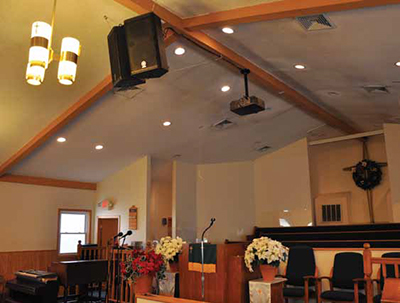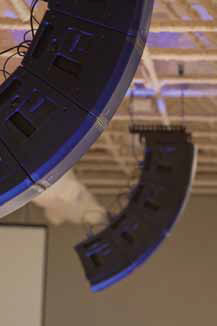Are Powered Loudspeakers Right for Your Next Project?

Yamaha DSR speakers were installed at the New Hope Baptist Church in Atlantic City, NJ.The lure of simplicity is hard to deny. As powered loudspeakers bring networking capabilities and a reduced reliance on equipment racks — along with ever-important cost savings—integrators are beginning to accept the advantages the category offers, while learning to work around its perceived cons. SCN asked manufacturers to dig into the reasons integrators should consider powered loudspeakers for their next install as those products continue to evolve. Here’s what they had to say.
What new market developments are making powered speakers a more likely choice for permanent installation?
The market seems to be more accepting of powered loudspeaker systems as better networking capabilities are developed to improve system setup, operation, and monitoring. Another factor is the more efficient amplifier designs and lighter weight packages. A third factor is operational costs, as powered systems do not require an environmentally controlled equipment room and all the costs associated with HVAC systems. For the integrator, it is likely there would be cost savings in shop and jobsite labor as well as savings in inventory costs by not having to purchase racks and associated accessories to build the racks. And finally, as the next generation of integrators become the leaders and managers of AV companies, they are likely to be more accepting of powered loudspeaker systems simply because they have grown up with computers, the evolution of networks, and powered loudspeakers.
Class D and Class I amplifier technology continues to evolve into being more compact, lighter weight, reliable, and more efficient components of a loudspeaker system. Utilizing the same cable for digital signal input and networking capabilities isn’t necessarily new, but it is ever-evolving technology.
—Jon Sager, Senior Manager, Market Development for Installed Sound, JBL Professional

Comal restaurant in Berkeley, CA features 14 Meyer Sound UP-4XP and two UPJ-1P VariO loudspeakers.Many installers are becoming more comfortable with using powered loudspeakers in part because the technology and reliability of these products have been proven. There also seems to be less opposition in some circles to having to run AC lines for loudspeakers, which were often cited as an objection, since contractors have to do so to accommodate digital signage and other video.
Powered loudspeakers can offer a number of advantages including minimizing or even eliminating the need for rack space because the amplifiers and signal processing are built into the loudspeaker. With a built-in amplifier and DSP processing on-board, components used in the system can all be optimized for maximum product performance. A pre-tuned, optimized loudspeaker can in turn lead to quicker and easier installs in some instances. Other benefits of powered loudspeakers are that they are often more power efficient, they don’t suffer from amplifier to transducer line loss and from a wiring cost perspective, powered loudspeakers reduce the amount of copper and cable required because line level signal as opposed to loudspeaker voltage levels are being run.
—Phil Sanchez, Product Manager, QSC
Self-powered speakers’ strongest advantages are in single cabinet per output channel applications where you would require separate processing and amplification for each speaker anyway, and for rental applications where you are changing the system configuration frequently and don’t want to have to think about how many cabinets each amp rack can handle. Many customers we talk with about installing self-powered systems for larger applications are concerned about the cost of electrical distribution to the speaker locations, the extra weight of amplifiers in the cluster, and service and maintenance concerns with having the amplifiers more exposed to dirt and heat than they would be in a proper equipment room.
A daily selection of the top stories for AV integrators, resellers and consultants. Sign up below.

QSC KLA speakers at Mundo de Fey in Coppel, TX.That being said, self-powered speakers could be an excellent solution when you do not have a proper equipment room, such as a small church or club application where there is no convenient space to locate equipment racks. In these situations, self-powered might be easier that determining an appropriate location for an equipment rack and these smaller applications are more likely to have only one or two speakers for each signal. Self-powered speakers can also simplify installations for less technical personnel, as there are fewer opportunities for wiring errors or mismatches between speakers and amplifiers.
—Joe Rimstidt, Systems Engineer, Yamaha
We find that a number of customers choose to use powered speakers for installations due to the desire to eliminate an equipment rack and simply the system layout. With the extensive signal processing available within even small digital mixing consoles, it is now possible to have a complete sound system comprised of only a digital mixer and powered speakers.
Another benefit of powered speaker systems is the ability to distribute many speaker systems over a great distance, with only linelevel signal and power needed at the speaker location. We see this as being the future of system design, where a single Dante signal can be run throughout a facility, and individual channels of audio can be selected remotely for each separate speaker location.
—Ivan Schwartz, Western Regional Sales Manager, Tannoy
Traditional thinking says, “If the amps are on the deck, it’s easier to swap a component than if they’re in the air.” And that’s true. Only this: isn’t an amp failure pretty far down the list? Transducers are the single most common source of failure, usually user driven failures but still failures. And the transducers are in the air, right? In the end, designers and installers choose the approach with which they feel most comfortable. Putting amps inches from the loads they drive improves performance. Enough to overcome the concerns associated with a non-traditional approach…?
—John Speck, Marketing Director, Eastern Acoustic Works
As the demand for high audio quality for both music and speech rises in retail, hospitality, and other commercial applications, self-powered loudspeakers become a natural solution for these applications as well. Meyer Sound’s expanding line of 48 V, DC-powered loudspeakers is designed specifically for commercial applications where high quality sound and low profile are desired. Because these self-powered systems have no transformer and line losses between amplifier and loudspeaker, they provide much greater performance and power-to-size ratios than conventionally powered systems.
—Pablo Espinosa, Vice President of Research and Development, Meyer Sound
Derek Dellinger is the web editor of SCN.
